Zelensky slams the West over Polish fighter jet confusion: 'Solve it faster' - New York Post posted at 17:44:14 UTC via "Zelensky" - Google News
- Get link
- X
- Other Apps
Russia - Ukraine war | Post Link

Ukrainian President Volodymyr Zelensky slammed the West Wednesday in response to the latest delay in getting fresh fighter jets to Ukrainian pilots.
The latest twist in the weeks-long saga of approximately two dozen Polish MiGs came Tuesday, when Pentagon officials shot down Warsaw’s plan to transfer the Soviet-era fighter jets to Ukraine via a US airbase in Germany.
The United States has been vocal about the need to supply weapons to Ukraine, but the prospect of flying combat aircraft from NATO territory into the war zone “raises serious concerns for the entire NATO alliance,” Pentagon press secretary John Kirby said in a statement.
Zelensky panned Washington’s concerns as “a technical issue” in his Wednesday address to the Ukrainian people.
“Listen, we have a war,” he said. “We do not have time for all this signaling. This is not ping pong, this is about human lives.”
Get the latest updates in the Russia-Ukraine conflict with The Post’s live coverage.
“Solve it faster,” he urged Western officials. “Do not shift the responsibility — send us planes.”
Zelensky again called on NATO governments to “close the sky” over Ukraine by imposing a no-fly zone.
“Russia uses missiles, aircraft, and helicopters against us, against civilians, against our cities, against our infrastructure,” he said. “If you do not close the sky, you will also be responsible for this catastrophe.”
Zelensky also said Wednesday that Ukrainian ground forces had been able to effectively resupply using captured and abandoned Russian hardware.
“Our military and territorial defense units managed to replenish their arsenal due to the many pieces of equipment they took on the battlefield,” Zelensky said. “Enemy tanks, armored vehicles and ammunition will now work for our defense.”
“What could be more humiliating for the invaders?” he added. “We will beat the enemy with his own weapons.”
“Russian soldiers, you still have a chance to survive,” he added. “Almost two weeks of resistance have shown you that we will not give up, because this is our home. These are our families and children. You can still be saved if you just leave.”
The Ukrainian president confirmed that a humanitarian corridor for the safe passage of civilians had been established between Sumy, near the Russian border, and Poltava, 100 miles to the south. He said 1,600 students and 3,500 residents had been safely evacuated from Sumy as a result.
Zelensky also said that a team of Ukrainian negotiators had recently returned from Belarus, where talks with Moscow were being held. The foreign ministers of Russia and Ukraine are scheduled to meet Thursday for talks in the Turkish resort city of Antalya.
German Chancellor Olaf Scholz on Wednesday said he did not support a proposal from Poland to deliver Soviet-era MiG-29 fighter jets to Ukraine via the US Ramstein Air Base in Germany.
Speaking at a press conference in Berlin alongside Canadian Prime Minister Justin Trudeau, Scholz said Germany had already sent defensive weapons and "significant" financial support and humanitarian aid to Ukraine.
"Apart from that, we have to think very carefully about what we are doing, and this certainly does not include fighter jets," the chancellor said.
Trudeau said Canada will continue to send equipment and weapons to Ukraine by working alongside its partners.
"We want to de-escalate the conflict, we want to see an end to this conflict," he said.
0 seconds of 0 secondsVolume 90%
Play/PauseSPACE
Increase Volume↑
Decrease Volume↓
Seek Forward→
Seek Backward←
Captions On/Offc
Fullscreen/Exit Fullscreenf
Mute/Unmutem
Seek %0-9
Scholz: Germany won't send fighter jets to Ukraine
What was the Polish proposal?
On Tuesday, Poland had outlined a plan to take its 28 MiG-29 fighters, which would be familiar to Ukrainian pilots, to the US air base in Germany.
The expectation was that the aircraft would eventually be handed over to the Ukrainian air force.
The US would, in return, then have supplied Poland with US-made jets that had the "corresponding capabilities," such as the F-16s that are already a mainstay of the Polish air force.
However, the Poles hadn't first cleared that idea with the Biden administration, and the idea was quickly dismissed by the Pentagon.
On Wednesday, Poland appeared to walk back the proposal, with Prime Minister Mateusz Morawiecki saying a decision to provide Polish fighter jets to Ukraine needed to be made jointly by NATO members.
"We did not agree to supply planes by ourselves because it must be the decision of the whole of NATO," Morawiecki said during a press conference on Polish television.
"The USA does not want these planes to come to Ukraine from American bases," the Polish presidency's foreign affairs adviser, Jakub Kumoch, told public broadcaster TVP Info.
"Poland is ready to act, but only within the framework of the alliance, within the framework of NATO," he added.
0 seconds of 0 secondsVolume 90%
Play/PauseSPACE
Increase Volume↑
Decrease Volume↓
Seek Forward→
Seek Backward←
Captions On/Offc
Fullscreen/Exit Fullscreenf
Mute/Unmutem
Seek %0-9
Ukraine: Russian onslaught likely to get worse
Why is the West wary?
While the gift of MiG-29s would be a morale booster for Ukrainians, it would also risk the possibility of the war spreading beyond the country.
Russia has already warned other nations and parties not to get involved in the conflict. The Kremlin said on Wednesday that Poland's offer of fighter jets was "highly undesirable and a potentially dangerous scenario."
Questions also remain over whether the planes would be enough to influence the course of fighting in Ukraine. The number of aircraft is relatively small and the MiG-29s also are inferior to more sophisticated Russian planes. They could possibly easily be targeted by Russian pilots and Russian missiles.
What is the Ukrainian position?
Ukrainian President Volodymyr Zelenskyy on Tuesday denounced what he called the West's unkept "promises" to protect Ukraine from Russian attacks. He said assurances received so far have not been fulfilled.
Zelenskyy said on Wednesday the international community would be responsible for a mass "humanitarian catastrophe" if it did not agree a no-fly zone to protect his country.
"When will there be a decision? Look, we're at war!" Zelenskyy said in a video on his Telegram channel. "We ask you again to decide as soon as possible. Send us planes."
Establishing a no-fly zone over Ukraine, something also sought by Zelenskyy, has been rejected by Washington and NATO.
Russian President Vladimir Putin has threatened "colossal and catastrophic consequences" for Europe and the wider world, should a no-fly zone be implemented.
0 seconds of 0 secondsVolume 90%
Play/PauseSPACE
Increase Volume↑
Decrease Volume↓
Seek Forward→
Seek Backward←
Captions On/Offc
Fullscreen/Exit Fullscreenf
Mute/Unmutem
Seek %0-9
Berlin welcomes thousands of refugees from Ukraine
US vice president pays a visit
US Vice President Kamala Harris is traveling to Poland on Wednesday for what was planned to be a chance to thank Warsaw for taking in hundreds of thousands of Ukrainians fleeing their country after Russia's invasion.
She's also visiting Romania and is widely expected to reassure both countries of Washington's support.
Both Bucharest and Warsaw are increasingly wary of Russia's increased aggression in the region and are NATO's easternmost members. They each share a border with Ukraine, where thousands of refugees are arriving each day.
Harris is also expected to look at how NATO members can implement the economic sanctions put in place and remain aligned and move forward together.
She is due to talk to Ukrainian refugees in Poland and will discuss the war-related issues with Canada's Prime Minister Justin Trudeau, who is also visiting Warsaw after meeting German Chancellor Olaf Scholz in Berlin on Wednesday.
wmr,rc/msh (AFP, AP, Reuters)
Russia and Ukraine agreed to open more humanitarian corridors on Wednesday (File)
Russian President Vladimir Putin and German Chancellor Olaf Scholz on Wednesday discussed diplomatic ways to settle the Ukraine conflict and the implementation of humanitarian corridors to evacuate civilians, the Kremlin said.
"In the context of the developing situation around a special military operation to protect Donbas, various political and diplomatic efforts have been discussed, in particular a third round of talks between a Russian delegation and representatives of the Kyiv authorities," the Kremlin said in a statement, referring to eastern Ukraine.
The Kremlin said that the two leaders discussed "the humanitarian aspects of the situation" in Ukraine and separatist regions.
Putin informed Scholz of measures being taken to evacuate civilians and "attempts of fighters of nationalist groupings" to scupper those plans.
Russia and Ukraine agreed to open more humanitarian corridors on Wednesday to evacuate terrified civilians from bombarded cities, while new concerns emerged over the Chernobyl nuclear plant after a power cut.
As fighting raged on the 14th day of what the Kremlin has termed a "special military operation", safe routes were opening out of five Ukrainian areas including suburbs of the capital Kyiv that have been devastated by Russian shelling and air strikes.
Comments (Except for the headline, this story has not been edited by NDTV staff and is published from a syndicated feed.)
March 9 | Few advances and new bombings
The Russian army has made very small advances in the last few days, but it continues to bomb Kharkiv, Chernihiv, Sumy and Mariupol, Ukraine’s main cities, as it prepares for a potential siege of Kyiv. Russia said that starting on Wednesday it would open humanitarian corridors in these five cities, where it will temporarily halt its attacks.
The Russian army is also reportedly concentrating new troops on all its fronts, according to the Institute for the Study of War (ISW).
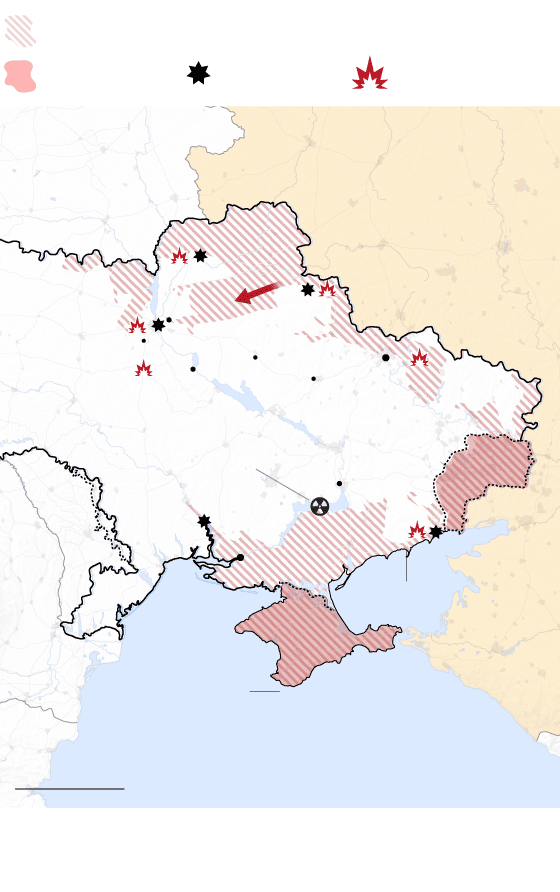
Russian troop advance (at March 8)
Control ruso
Combat
Bombing
BELARUS
RUSSIA
Chernihiv
Sumy
Bovari
Kyiv
Vasilikiv
Lubni
Bila Tserkva
Kharkiv
Kaniv
Poltava
UKRAINE
Nuclear
power plant
Zaporizhzhia
Mykolaiv
MOLD.
Odessa
Mariupol
Kherson
Berdiansk
Crimea
Annexed by
Russia in 2014
Black Sea
300 km
Sources: Occupied territories (ISW).
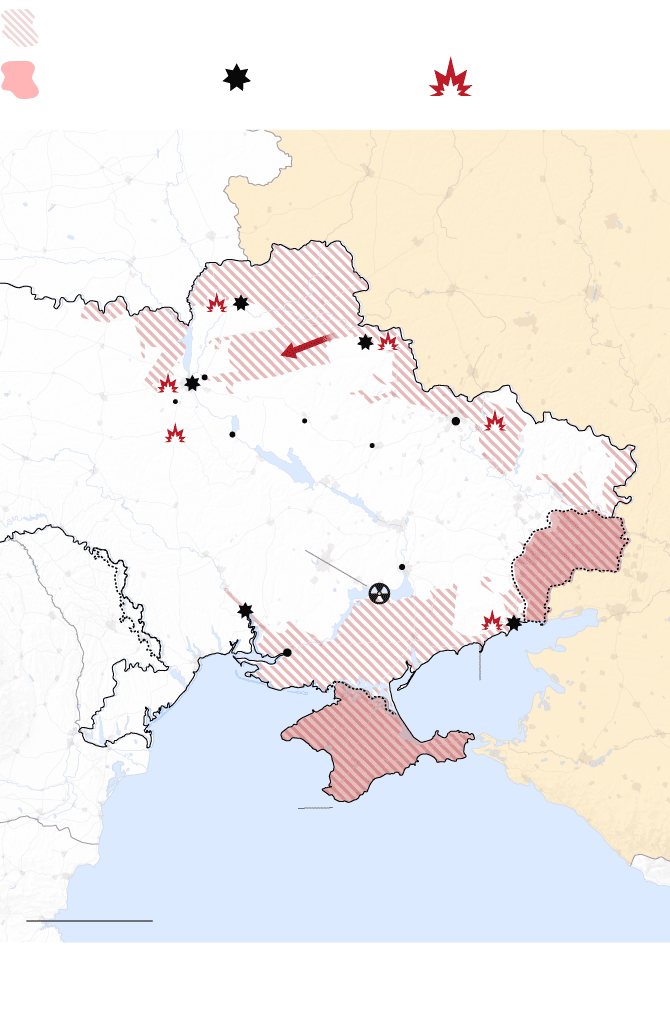
Russian troop advance (at March 8)
Control ruso
Combat
Bombing
BELARUS
RUSSIA
Chernihiv
Sumy
Bovari
Kyiv
Vasilikiv
Lubni
Bila Tserkva
Kharkiv
Kaniv
Poltava
UKRAINE
Nuclear
power plant
Zaporizhzhia
Mykolaiv
MOLD.
Odessa
Mariupol
Kherson
Berdiansk
Crimea
Annexed by Russia
in 2014
Black Sea
300 km
Sources: Occupied territories (ISW).
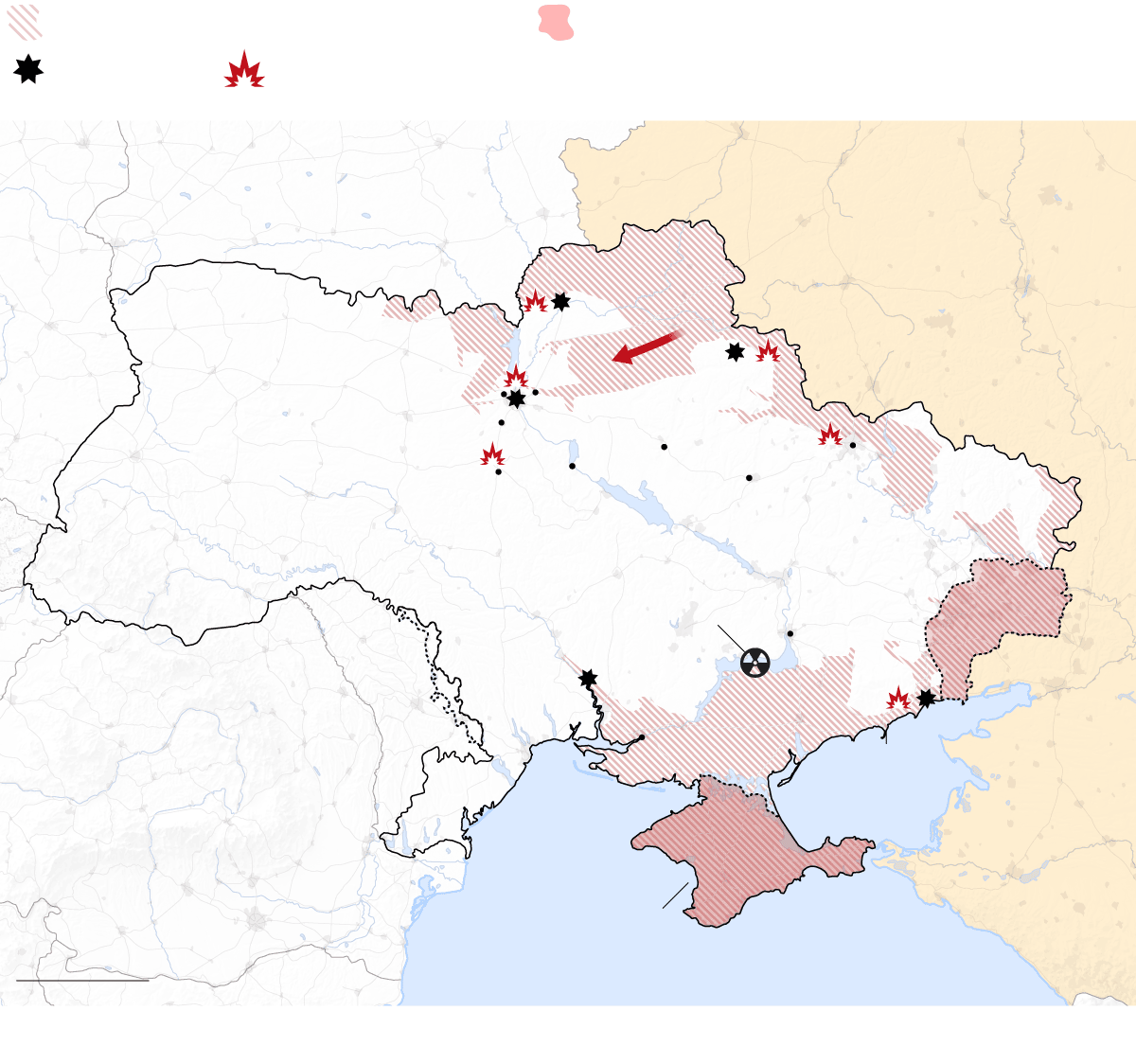
Russian troop advance (at March 8)
Under Russian control
Combat
Bombing
RUSSIA
BELARUS
Gomel
Chernihiv
Voronezh
Belgorod
POLAND
Sumy
Brovary
Irpin
Kyiv
Yitomir
Vasilikiv
Lubni
Kharkiv
Bila Tserkva
Kaniv
Poltava
Ivano-Frankivsk
UKRAINE
Donbass
Nuclear
power plant
Zaporizhzhia
MOLD.
Mykolaiv
Mariupol
Kherson
Odessa
ROMANIA
Berdiansk
Sea of Azov
Crimea
Annexed by Russia
in 2014
250 km
Sources: Occupied territories (ISW), Rochan Consulting and agencies.
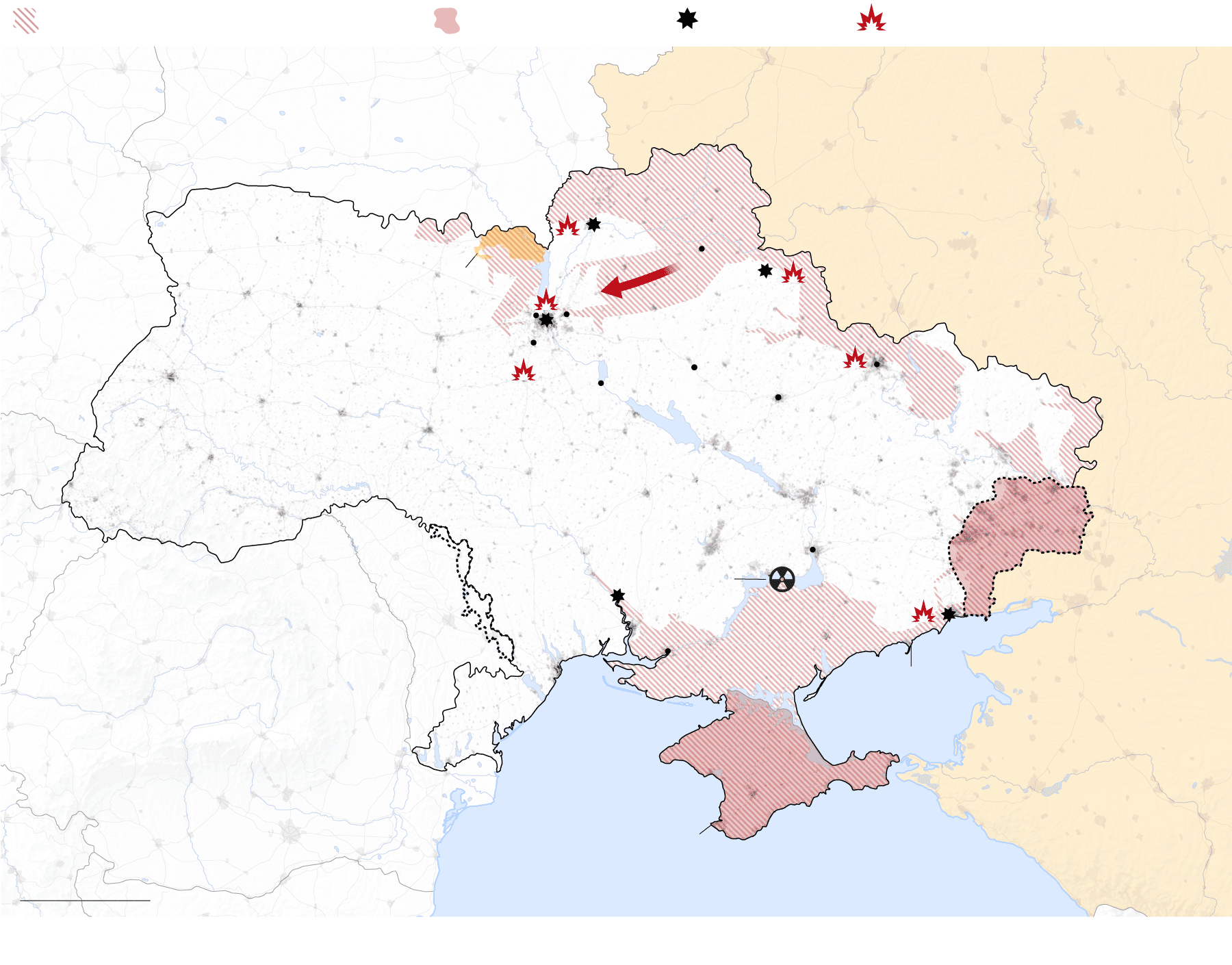
Russian troop advance (at March 8)
Under Russian control
Combat
Bombing
BELARUS
Gomel
RUSSIA
Kursk
Voronezh
Chernihiv
Konotop
Chernobyl exclusion zone
Belgorod
Sumy
POLAND
Brovary
Irpin
Kyiv
Vasilikiv
Yitomir
Lviv
Lubni
Kharkiv
Kaniv
Bila Tserkva
Poltava
UKRAINE
Dnipro
Donbas
Zaporizhzhia
Nuclear
power plant
MOLD.
Mykolaiv
t
Mariupol
Kherson
Odessa
Berdiansk
ROMANIA
Sea of Azov
Crimea
Annexed by Russia
in 2014
Black Sea
250 km
Sources: Occupied territories (ISW), Rochan Consulting and agencies.
Near the capital, the most active front is in Irpin, in the western outskirts of Kyiv, where civilians have been hit by shelling in recent days. Russian troops did not make any gains, but they are reportedly concentrating their forces ahead of new operations. All analysts agree that Russia’s goal is to encircle Kyiv and force it to surrender.
In northeastern Ukraine there was fighting in Chernihiv and in Sumy, two cities from which Russian troops are trying to create a communication line to Kyiv. In the east, British intelligence services reported shelling in Kharkiv, Ukraine’s second biggest city. From here, it is believed that Russian forces are seeking to connect with the troops currently deployed in the Donetsk and Donbas regions to create a large front in this part of the country.
Russian troops have reportedly made their greatest advances in the south this past week. There are reports that they have encircled Mariupol and may be trying to advance towards Zaporizhya, which is home to Ukraine’s largest nuclear power plant. Everything seems to indicate that they are coming near Odessa, the main port on the Black Sea.
March 8 | Supplies and reinforcements for the siege
Russian troop movement around Kyiv has several goals: surrounding the capital from several sides, accumulating supplies and reinforcements, and cutting off the city’s links to the outside world, according to the ISW. The Kremlin is reportedly massing tanks and men on two flanks: the northwest one, where it is trying to gain control of the cities of Irpin, 15 miles from the capital, and Bucha, three miles further north. On the eastern flank, the target is Brovary, a small town in the outskirts of Kyiv. In both cases Russian soldiers are running into resistance from Ukrainians.
Shelling has also been reported in the last two days around 59 miles south of the capital, in the city of Bila Tserkva. This could be an attempt to reach Kyiv from a front where there was little activity in previous days, according to the Rochan Institute and The Guardian.
Irpin, a dormitory town of around 60,000 residents, has become a containment wall against Russia’s advance west of the capital. It was targeted for bombing at the beginning of the invasion and it has been the scene of fighting over the past week.
Russian soldiers may be using “siege-and-starve” tactics on the city, using a strategy that was already used in Syria, according to the ISW. The goal is to get the population to surrender by preventing water and food from coming in, said Ukrainian authorities.
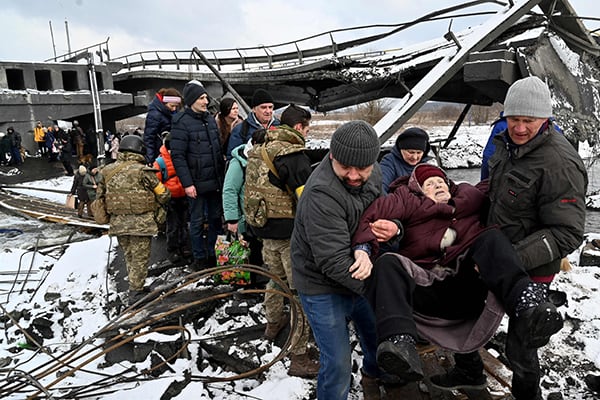
Evacuation in Irpin on the bridge to Kyiv on Tuesday, after a safe passage was opened. Sergey Supinsky (AFP).
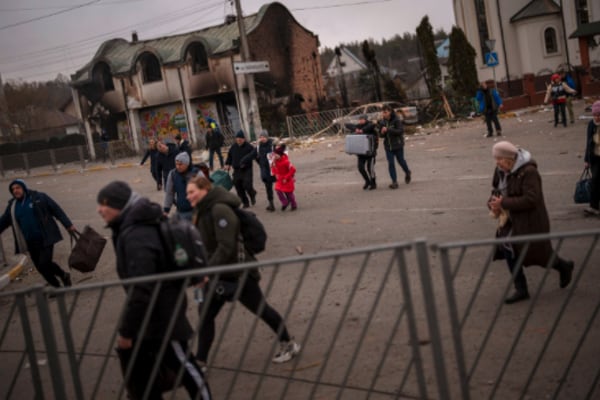
A day earlier, Russian troops had fired on civilians leaving Irpin on that same bridge to the capital. Emilio Morenatti (AP).
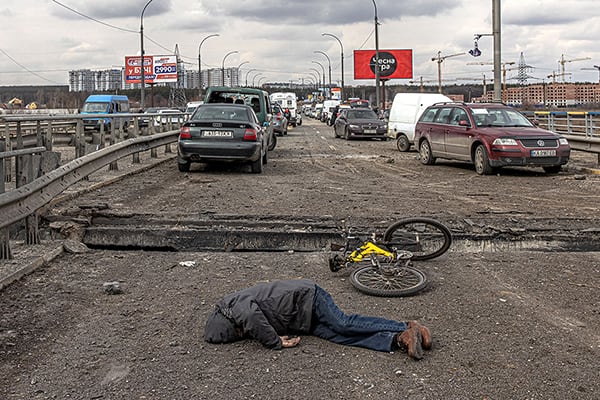
The Russian attack on the bridge area caused several civilian casualties among Ukrainians. Roman Pilipey (EFE).
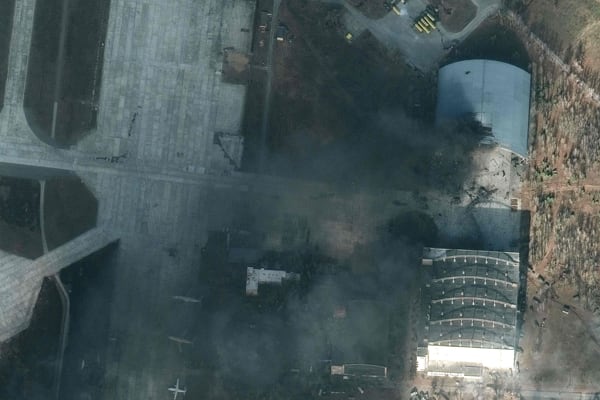
Irpin and the surrounding area was bombed at the beginning of the invasion, and Hostomel airport was rendered useless. Planet Labs (PBC).
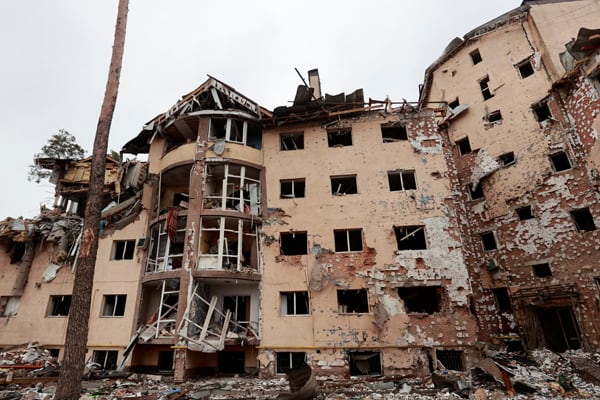
A residential neighborhood in the north came under heavy shelling between March 1 and 2. Serhii Nuzhnenko (Reuters).
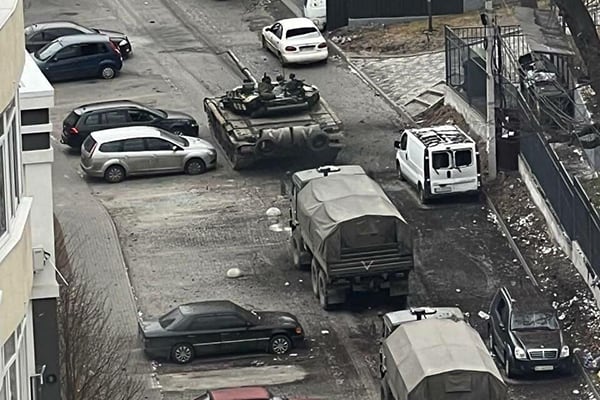
The fighting reached the city. There are images of Russian tanks in a neighborhood near the Bucha River. @Militarylandnet.
Last Sunday, images of civilians killed by artillery fire as they were trying to flee Irpin created greater pressure for humanitarian corridors to evacuate people and bring in supplies. Attempts at establishing safe passages failed on Monday, but were established on Tuesday in Sumy and Irpin. Around 150 people had fled the latter city in the early morning hours, according to local authorities.
In the east, fighting continued in major cities such as Kharkiv and Sumy, where a bomb attack killed at least 10 people according to Ukrainian authorities. The city of Mariupol is reportedly surrounded by Russian troops.
In the south, a bloody battle took place on Monday for control over the city of Mykolaiv, according to The New York Times. This is a key port on the Black Sea and would help Moscow prepare its attack on Odessa. If it manages to take both cities, Russia will have almost total control over the country’s access to the sea.
FROM his puffy face to a professor's cancer claims, there are five clues Vladimir Putin could be seriously ill.
It's thought the Russian leader's decision to invade Ukraine might have been sparked by not only his unhinged mental state, but also by a worrying physical health condition.
Putin, 69, was described as "ashen and bloated" in pictures released by the Kremlin.
The Russian president, normally cutting a rugged and manly figure, looked pale and unfit as his forces pounded Ukraine’s cities.
Putin is tight-lipped about his health - but there has been much speculation over the years.
Researchers even claimed they identified signs in Putin's gait which could point to Parkinson's disease.
The Kremlin has not commented on the 2022 speculation that Putin is ill.
But here are five clues puffy-faced Putin could be seriously ill.
'Bloated' appearance
Putin has appeared notably more bloated around the face and neck in recent weeks - suggesting he might be undergoing treatment with steroids for a health condition.
Side effects of steroids include increased risk of infection - which it is claimed could explain his paranoia about catching Covid.
Steroids can also spark "mood and behavioural changes".
According to Macmillan Cancer Support, a high dose of steroids can cause confusion or even changes in thinking.
"This can include having strange or frightening thoughts," the charity says.
Fiona Hill, the British former senior White House expert on Russia, told Politico: "Putin’s not looking so great, he’s been rather puffy-faced.
"We know that he has complained about having back issues.
"Even if it’s not something worse than that, it could be that he’s taking high doses of steroids, or there may be something else.
"There seems to be an urgency for this that may be also driven by personal factors."
She added: "He may have a sense that time is marching on - it’s 22 years (in power), after all, and the likelihood after that kind of time of a Russian leader leaving voluntarily or through elections is pretty slim.
"Most leaders leave either like Belarusian president Alexander Lukashenko thought that he might leave, as the result of massive protests, or they die in office."
Former foreign secretary and medical doctor Lord Owen said changes in Putin's face made it appear he had been taking steroids, which can make you more vulnerable to Covid.
Lord Owen told Times Radio: "Look at his face, see how that has changed - he now has an oval face.
"People who said, oh, it's plastic surgery or Botox, I don't believe that at all.
"He's on either anabolic steroids as a bodybuilder - and he's very proud of his muscles and strips to the waist and everything like that - or he's on corticosteroids.
"If you're on these drugs, this gives you this face.
"It reduces your immunity and makes you more vulnerable to Covid."
He added: "This man has been in complete isolation, quite extraordinary, won't see anybody, stays miles away, tremendous pressures.
"Which indicates he's on a steroid and probably, maybe, a combination of both.
"And we ought to fess up to it, that carries with it, particularly anabolic steroids, bodybuilders, aggressiveness that comes through.
"I think his personality has changed, but don't believe he's mad.
"He's a very clever and able, and somebody who you don't want as an enemy, and he's ruthless."
'Parkinson's disease & cancer'
Political scientist Valery Solovei has previously claimed Putin has cancer as well as symptoms of Parkinson's Disease.
He claimed the Kremlin boss had emergency surgery in February 2020
Speaking that year, Prof Solovei said of Putin's twin health traumas: “One is of psycho-neurological nature, the other is a cancer problem.
“If anyone is interested in the exact diagnosis, I'm not a doctor, and I have no ethical right to reveal these problems.
”The second diagnosis is a lot, lot more dangerous than the first named diagnosis as Parkinson’s does not threaten physical state, but just limits public appearances.
“But there is a fatal diagnosis.
“Based on this information people will be able to make a conclusion about his life horizon, which wouldn’t even require specialist medical education.”
Prof Solovei - the former head of the Public Relations Department at Moscow State Institute of International Relations - claims Putin underwent surgery in February that year.
Another Russian source went on to claim it was an abdominal cancer operation.
It was even claimed the Russian leader was planning to announce his Kremlin exit early in 2021.
But at the time, Putin's spokesman Dmitry Peskov branded it "absolute nonsense" as he insisted everything was "fine" with the president.
The bizarrely long meeting tables
People who are taking immune-suppressing medication, such as cancer patients or those with chronic conditions, are known to be at a higher risk of contracting a severe case of Covid.
And there has been a flurry of speculation over whether this is behind Putin's decision to sit metres away from foreign leaders and even his own colleagues.
In a case of extreme social distancing, Emmanuel Macron was forced to sit at the other end of a 13ft table during a meeting with the Russian president.
Putin's own foreign minister Sergei Lavrov was also seated at the other end of an absurdly long table.
Many of Putin's visitors, including both staff and politicians, have reportedly been forced to quarantine in hotels for two weeks before meeting him.
It was also reported visitors to the Kremlin had to walk through an elaborate disinfectant-spraying tunnel.
His extreme measures have sparked rumours that the leader is terrified of catching Covid because he's vulnerable to a severe infection.
Intelligence claims
Republican senator Marco Rubio - who has access to classified intelligence - raised eyebrows last week when he tweeted that "something is off" with Putin.
The senior politician is on the Senate Intelligence Committee and is not allowed to talk about the information he views.
But in what appears to be a hint, Rubio said Putin was facing a "different and significant" problem.
"I wish I could share more, but for now I can say it’s pretty obvious to many that something is off with Putin," he wrote.
"He has always been a killer, but his problem now is different & significant.
"It would be a mistake to assume this Putin would react the same way he would have five years ago."
He later added that Putin "appears to have some neuro/physiological health issues" - but did not expand further.
Pressure is piling on the US to release any intelligence that might reveal if Putin is indeed ill - with one former White House national security official telling the Telegraph the US should "make it personal".
Putin's race to restore Soviet glory
Putin has been slowly but surely carrying out his grand plans to restore Soviet glory.
In 2008, he invaded Georgia - and six years later, he annexed Crimea.
And under changes to the Russian law made in early 2021, he can now remain president until 2036.
This would give gangster Putin plenty of time for incremental land grabs using what some have dubbed "salami tactics" by taking Ukraine "slice by slice" over a long period time.
Therefore, many have been left puzzled as to why he would take such a huge gamble on taking over the whole of Ukraine in one go - unless he was unwell and had limited time.
It increases the suspicion that perhaps his physical health means he is running out of time.
If you’re hoping that the instability that Vladimir Putin’s war on Ukraine has wreaked on global markets and geopolitics has peaked, your hope is in vain. We haven’t seen anything yet. Wait until Putin fully grasps that his only choices left in Ukraine are how to lose — early and small and a little humiliated or late and big and deeply humiliated.
I can’t even wrap my mind around what kind of financial and political shocks will radiate from Russia — this country that is the world’s third-largest oil producer and possesses some 6,000 nuclear warheads — when it loses a war of choice that was spearheaded by one man, who can never afford to admit defeat.
Why not? Because Putin surely knows that “the Russian national tradition is unforgiving of military setbacks,” observed Leon Aron, a Russia expert at the American Enterprise Institute, who is writing a book about Putin’s road to Ukraine.
“Virtually every major defeat has resulted in radical change,” added Aron, writing in The Washington Post. “The Crimean War (1853-1856) precipitated Emperor Alexander II’s liberal revolution from above. The Russo-Japanese War (1904-1905) brought about the First Russian Revolution. The catastrophe of World War I resulted in Emperor Nicholas II’s abdication and the Bolshevik Revolution. And the war in Afghanistan became a key factor in Soviet leader Mikhail Gorbachev’s reforms.” Also, retreating from Cuba contributed significantly to Nikita Khrushchev’s removal two years later.
In the coming weeks it will become more and more obvious that our biggest problem with Putin in Ukraine is that he will refuse to lose early and small, and the only other outcome is that he will lose big and late. But because this is solely his war and he cannot admit defeat, he could keep doubling down in Ukraine until … until he contemplates using a nuclear weapon.
Why do I say that defeat in Ukraine is Putin’s only option, that only the timing and size is in question? Because the easy, low-cost invasion he envisioned and the welcome party from Ukrainians he imagined were total fantasies — and everything flows from that.
Putin completely underestimated Ukraine’s will to be independent and become part of the West. He completely underestimated the will of many Ukrainians to fight, even if it meant dying, for those two goals. He completely overestimated his own armed forces. He completely underestimated President Biden’s ability to galvanize a global economic and military coalition to enable Ukrainians to stand and fight and to devastate Russia at home — the most effective U.S. coalition-building effort since George H.W. Bush made Saddam Hussein pay for his folly of seizing Kuwait. And he completely underestimated the ability of companies and individuals all over the world to participate in, and amplify, economic sanctions on Russia — far beyond anything governments initiated or mandated.
When you get that many things wrong as a leader, your best option is to lose early and small. In Putin’s case that would mean withdrawing his forces from Ukraine immediately; offering a face-saving lie to justify his “special military operation,” like claiming it successfully protected Russians living in Ukraine; and promising to help Russians’ brethren rebuild. But the inescapable humiliation would surely be intolerable for this man obsessed with restoring the dignity and unity of what he sees as the Russian motherland.
Incidentally, the way things are going on the ground in Ukraine right now, it is not out of the realm of possibility that Putin could actually lose early and big. I would not bet on it, but with every passing day that more and more Russian soldiers are killed in Ukraine, who knows what happens to the fighting spirit of the conscripts in the Russian Army being asked to fight a deadly urban war against fellow Slavs for a cause that was never really explained to them.
Given the resistance of Ukrainians everywhere to the Russian occupation, for Putin to “win” militarily on the ground his army will need to subdue every major city in Ukraine. That includes the capital, Kyiv — after probably weeks of urban warfare and massive civilian casualties. In short, it can be done only by Putin and his generals perpetrating war crimes not seen in Europe since Hitler. It will make Putin’s Russia a permanent international pariah.
Moreover, how would Putin maintain control of another country — Ukraine — that has roughly one-third the population of Russia, with many residents hostile to Moscow? He would probably need to maintain every one of the 150,000-plus soldiers he has deployed there — if not more — forever.
There is simply no pathway that I see for Putin to win in Ukraine in any sustainable way because it simply is not the country he thought it was — a country just waiting for a quick decapitation of its “Nazi” leadership so that it could gently fall back into the bosom of Mother Russia.
So either he cuts his losses now and eats crow — and hopefully for him escapes enough sanctions to revive the Russian economy and hold onto power — or faces a forever war against Ukraine and much of the world, which will slowly sap Russia’s strength and collapse its infrastructure.
As he seems hellbent on the latter, I am terrified. Because there is only one thing worse than a strong Russia under Putin — and that’s a weak, humiliated, disorderly Russia that could fracture or be in a prolonged internal leadership turmoil, with different factions wrestling for power and with all of those nuclear warheads, cybercriminals and oil and gas wells lying around.
Putin’s Russia is not too big to fail. It is, however, too big to fail in a way that won’t shake the whole rest of the world.
The fourth round of Russian-Ukrainian talks on settling the situation in Ukraine will take place in the near future, Leonid Slutsky, a member of the Russian delegation and head of the State Duma Committee on International Affairs, said at a briefing on March 7 after the end of the third round of talks held in Belovezhskaya Pushcha in Belarus.
The MP noted that it is difficult to negotiate. “Tough partners, and we imagined it ,” Slutsky said. According to him, the next round of negotiations will take place in the near future, but one cannot hope that the Ukrainian side will immediately take a position close to the Russian one and will impeccably implement it.
“Negotiations will really quickly continue. Let's not flatter ourselves with the illusion that the next step, through the step, will reach the final result. It will be quite hard and consistent work , ”Slutsky added. He stressed that the consultations would not be easy.
Slutsky also noted the importance of the issue of humanitarian corridors through which civilians could go.
“Thousands and thousands of people are waiting in Mariupol, in Volnovakha. They are waiting for the opportunity to save their lives, the lives of their children and parents. those people who shoot at them and do not allow them to pass through the humanitarian corridors. They are essentially fascists. These, in fact, are simply non-humans who hide behind people as a human shield, preventing them from passing through open humanitarian corridors , ”said the parliamentarian.
Slutsky added that at the last talks, the parties discussed the details of the use of humanitarian corridors in sufficient detail in specific areas. The deputy expressed hope that attempts to take people out would be made in the shortest possible time and would be successful.
Recall that since February 24, Russia has been conducting a special military operation to demilitarize and denazify Ukraine, whose authorities have carried out genocide of the inhabitants of Donbass for almost eight years. As Russian President Vladimir Putin stated, we are not talking about the occupation of the territory of Ukraine. The Ministry of Defense of the Russian Federation emphasized that the strikes were carried out only on military targets.
Russian-Ukrainian negotiations to resolve the situation in Ukraine are taking place on the territory of Belarus. The first round of negotiations took place on February 28, and the second round on March 3.
While at the airfield, Milley met with troops and personnel and examined the shipment activity, the official said Friday. The site has become a beehive of activity in recent days, going from a handful of flights each day to as many as 17, the field's maximum capacity.
The airport's location remains a secret to protect the shipments of weapons, including anti-armor missiles, into Ukraine. The Russian military has not targeted these shipments once they enter Ukraine, the official said, but there is some concern Russia could begin targeting the deliveries as its assault advances.
The US and other NATO members have so far sent Ukraine 17,000 anti-tank missiles and 2,000 stinger anti-aircraft missiles, a senior US official told CNN.
Since even before Russia's invasion began late last month, the skies above Europe have been filled with military cargo aircraft of the US and others, particularly C-17s, the backbone of the US airlift fleet. The flights have been repositioning troops along NATO's eastern flank, but also moving weapons to the transfer points where they can be delivered to Ukraine. The pace of the flights has only increased.
US European Command (EUCOM) is at the heart of the massive shipment operation, using its liaison network with allies and partners to coordinate "in real time" to send materials into Ukraine, a second Defense official said.
EUCOM is also coordinating with other countries, including the United Kingdom, in terms of the delivery process "to ensure that we are using our resources to maximum efficiency to support the Ukrainians in an organized way," the official added.
Since Russia's invasion began, 14 countries have sent security assistance to Ukraine, the official said, some of whom had rarely sent such substantial equipment before.
The
"vast majority"of a $350 million US security assistance package has already been delivered to Ukraine, according to the official, only one week after it was officially approved by the White House.
Approximately $240 million of the package has reached Ukraine, and the rest should arrive within days and maybe weeks, "but not longer," the official said Friday. The components that have already been delivered include "the most needed capabilities, like anti-armor capabilities."
Once in possession of the weapons, the Ukrainians have used them to slow and stall Russian assaults in different parts of Ukraine.
"I think all of us have been tremendously impressed by how effectively the Ukrainian Armed Forces have been using the equipment that we've provided them," the official said.
Perhaps most notably, a massive Russian convoy spanning 40 miles of road north of Kyiv, Ukraine's capital, has barely moved in days.
"We know that they have conducted attacks on that convoy, that those attacks were effective in slowing and stopping it," another senior Defense official said Friday.
The equipment being sent in is equipment on which the Ukrainians have already received training, including some "just-in-time" training in late December and early January, the senior official said, adding that the Ukrainians can "use proficiently" the vast majority of the military equipment being sent in.
The speed at which the US now delivers weapons to Ukraine is dramatically faster than just two months ago. Most of a $200 million package approved in late December was delivered within a month, though some ammunition has yet to be shipped, the official said.
Meanwhile, the complete $350 million package, which the official described as the largest presidential drawdown in history, should be completed within days or weeks.
This story has been updated with additional reporting.
Russia has a fascism problem and it’s not Ukraine
There is a rising tide of fascism around the world and Vladimir Putin’s Russia is very much part of that.
In a 2003 article, political scientist Laurence Britt lists 14 attributes of fascism: extreme nationalism, disdain for human rights, scapegoating enemies as a unifying cause, sexism and homophobia, tightly controlled media, obsessive security in a surveillance state, using religion to bolster political power, pampering economic and corporate elites at the expense of have-nots, suppressing organised labour, limiting intellectual and artistic expression to a narrow orthodoxy, excessive police powers and jailing as political tool, rampant cronyism and corruption, and fraudulent elections.
Russia today under Putin checks all 14 boxes. So what is Putin on about, claiming that his war against Ukraine is “denazification?”
Putin attacked Ukraine without a pretext. Having done so, he is creating one after the fact — otherwise there is no fig leaf of legitimacy to deny the claim that it is a war of aggression and hence a war crime.
In the days leading up to the war, Russia’s official spokespersons repeatedly denied that an invasion was imminent and dismissed such talk as “hysteria”. On 15 February, Russia announced a partial withdrawal of troops from the area of its “exercises”. Preparatory to sending tanks into the Donbas region on 22 February, Putin announced that this was all about unanswered questions about Nato expansion. Since Ukraine is not a member of Nato and has not even applied for membership, treating this as a casus belli — a situation that provokes or causes war — is, at best, premature. But this was only the logic for sending tanks to Donbas, not for the main invasion of Ukraine.
Nato in any case has turned out to be a paper tiger because any member joining the conflict could trigger a generalised European war, risking escalation to nuclear weapons. If anyone is in any doubt about the threat of nuclear escalation, the Russian side has made that risk explicit. Almost all of Europe, aside from countries that are very small or expressly neutral, is already either in Nato or the Russian camp. So it is unlikely that another country will risk direct involvement in the Ukraine conflict. This leaves me wondering what the actual purpose of Nato is, now there is no longer a Warsaw Pact on the other side.
Once the full-scale invasion started, Russia refused to call it an invasion or occupation, and passed a new law that made it a criminal offence attracting a 15-year sentence to contradict the official narrative.
All propaganda contains a kernel of fact to make it plausible and the conventional “Ukraine good, Russia evil” narrative lacks nuance. At a time of conflict there is a tendency for all sides to simplify the picture but we need to understand the wider context to tell propaganda apart from truth.
Does Ukraine have a Nazi problem? On the face of it, the accusation appears to be absurd because the country has a Jewish president and has seen a substantial revival of Jewish culture; a new memorial centre was opened as recently as last year at Babyn Yar, the site of a Nazi massacre.
But there is a darker side to the Ukrainian state. In 2021, hundreds of Ukrainians marched to commemorate the Ukrainian 14th Waffen Grenadier Division of the SS. To his credit, President Volodymyr Zelenskyy condemned the march and any attempt at rewriting history to glorify Nazism. More seriously, the neo-Nazi Azov regiment, formed to fight separatists, was integrated into the National Guard by former president Petro Poroshenko in 2018.
Though their numbers are small (about 900 — and they only admit to about 10% of these actually being Nazis), the symbolism of this move is deeply troubling. Zelenskiy has also attempted to jail critics, including Poroshenko. So Ukraine is not the pristine democracy some claim it to be. But it is nowhere near as far down the road to out-and-out facism as Russia is.
Into this sordid mix we add reports of African and Asian refugees fleeing the war zone being given a tough time in Ukraine and across the border in Poland.
All of this makes it hard to keep the message focused on Putin as a war criminal. If we are serious about opposing wars of aggression and fascism, those on the opposing side need to clean up their own act. Otherwise we are into arguing which kind of fascism is better. The correct answer: no kind.
Worldwide, the drift to fascism is deeply troubling. In the US, white supremacist groups are split on the Russia-Ukraine conflict because they see it as a war between states they support — Russia because it is clearly fascist and shares their values and Ukraine because it has a facist movement even if it is not in control of the government. The attempted coup in the US on 6 January 2021 is a small part of the de-democratisation of the US. Included in this is voter suppression targeting ethnic minorities and manipulating supreme court justice appointments to favour a rightward shift.
Another troubling aspect of the conflict is the way Ukrainian refugees with their white skin, blonde hair and blue eyes are treated as “relatable” by Western media in a way that refugees from other conflicts never were. I even heard one reporter saying the Ukraine war is so shocking because the refugees are “civilised”. Hold up there. In my book, racism is what’s not “civilised”.
Countries such as the US, Australia, Britain and France — and for that matter, Russia — that have played a major role in stoking up the number of refugees worldwide refuse to honour their obligations under the Convention Relating to the Status of Refugees — particularly with regards to conflicts in which they are directly involved. There is no “blue-eyed-blonde” clause in the convention. Right-wing media publish scare stories of hordes of people in leaky boats and this sort of xenophobia is increasingly mainstreamed.
Here in South Africa, it only took Herman Mashaba’s modest success with attacking foreigners to suck the ANC government into xenophobia. Operation Dudula, despite claims to the contrary, creates the atmosphere for xenophobic looting and vigilantism. Although we can rightly shame Western media for regarding blue-eyed blonde Ukrainians as “relatable”, it is hypocritical to do so if we are othering people from the rest of Africa.
So what is to be done?
We need to be clear on the Ukraine issue. It is a war of aggression. Russia is threatening the use of nuclear weapons and this is why they believe they will get away with it. The huge outpouring of sympathy for Ukraine is not out of place.
What is out of place is the lack of similar outrage about other conflicts and the lack of sympathy for refugees who are not considered “relatable” by racist media.
Most importantly, we need to be clear on what fascism is and why any drift in that direction is to be resisted — not only when the victims are “relatable”, whatever that means.
- A new emblem has surfaced in the Ukraine-Russia conflict: a "Z," stylized in a thick brushstroke.
- The "Z" was spotted on Russian tanks invading Ukraine and painted on the sides of military vehicles.
- It may have started off as a Russian signal for victory, but has been appropriated as a symbol of the far-right.
A new symbol of Russia's war against Ukraine has emerged — a white "Z" emblem, stylized in a thick brushstroke. It has found its way onto the signs and t-shirts of ultra-right, pro-Russian protesters, been painted on Russian tanks and military vehicles, and been worn as a show of support for Russia's invasion.
In the past several weeks, the "Z" has gone from a military marking to a potent symbol of support for Russia's invasion of Ukraine. And there are signs that Russian nationalist groups have co-opted the mark as well.
The emblem was first spotted on Russian tanks in February
The "Z" symbol was first spotted on February 22, emblazoned on Russian military vehicles rolling into Ukraine's Donetsk region.
Twitter commenters speculated that the "Z" symbols, which appeared on tanks framed by squares, triangles, and other painted shapes, could be a way to delineate infantries.
Kamil Galeev, a former Galina Starovoitova Fellow on Human Rights and Conflict Resolution at the policy think tank the Wilson Center, tweeted that some interpreted the "Z" as short for "za pobedy" — the Russian term for "victory." Others have guessed the "Z" is short for "zapad" (or west) and is meant to designate west-bound infantry.
The meaning of the symbol has yet to be confirmed by Russian military sources.
A symbol of Russian nationalism and a rallying cry in support of Putin
Despite the letter "Z" not being in the Cyrillic Russian alphabet, the letter appears to have woven itself into the broader Russian wartime narrative.
Cars were spotted around Russia emblazoned with the "Z" logo, and businesses have also co-opted the symbol.
On March 4, a crowd of pro-Russian far-right Serbian protesters marching in Belgrade waved signs decorated with the "Z."
Similarly, a group of Russian nationalist protesters in Leningrad were filmed wearing hoodies emblazoned with a white "Z" along with the words "We don't give up our own." It is unclear when the video was taken, but it surfaced on social media in the first week of March.
The slogan echoed false Russian propagandist claims that the invasion is meant to "liberate" and "de-Nazify" Ukraine — an independently-governed democracy led by a Jewish president.
On Sunday, a Russian gymnast appeared at a medal ceremony with a "Z" taped to his uniform
Russian gymnast Ivan Kuliak taped a "Z" symbol on the front of his uniform while accepting a medal at the gymnastics World Cup in Doha on Sunday. He came in third, behind Ukraine's Illia Kovtun, who came in first.
The International Gymnastics Federation has called on the Gymnastics Ethics Foundation to investigate Kuliak's actions.
Pro-Putin figures also donned the symbol. Maria Butina, a convicted Russian spy and current member of the Russian State Duma, was seen in a video removing her blazer and drawing a "Z" on her lapel.
The Biden administration is discussing how to supply Polish Soviet-era fighter jets to Ukraine, American officials say, after President Volodymyr Zelensky made a passionate plea to American legislators on Saturday for assistance in obtaining more lethal military aid, especially Russian-made jets that Ukrainian pilots know how to fly.
The White House said a deal with Poland was being discussed that would replace Poland’s planes with American F-16s, but Polish officials seemed less than enthusiastic. After President Andrzej Duda said last week that Poland would not supply planes, the office of Prime Minister Mateusz Morawiecki wrote on Twitter on Sunday: “Poland won’t send its fighter jets to #Ukraine as well as allow to use its airports. We significantly help in many areas.”
A jet-supply arrangement would require congressional approval and is being discussed with other NATO countries. But any such supply would be a sovereign decision of the country involved, not a NATO decision, because NATO wants to avoid any direct conflict with the Russian military in Ukraine or over its airspace.
On Sunday, Secretary of State Antony J. Blinken, visiting Moldova, said the United States was exploring the idea of supplying jets to Poland should Warsaw choose to send its own to Ukraine.
“We are looking actively now at the question of airplanes that Poland may provide to Ukraine and looking at how we might be able to backfill, should Poland decide to supply those planes,” Mr. Blinken said. “I can’t speak to a timeline, but I can just say we’re looking at it very, very actively.”
There are numerous practical questions, including how to provide replacement planes to Poland and how to get the Polish planes to Ukraine. The next tranche of F-16s for export are set to go to Taiwan, American officials said, and they are reluctant to delay them.
Mr. Zelensky has regularly asked for NATO to create a no-fly zone over Ukraine to prevent Russian aircraft from bombing, but NATO has been adamant that it will not confront the Russian military in or over Ukraine.
Weapons to shoot down Russian planes, like ground-to-air Stinger missiles, are being sent into Ukraine in large numbers through its western borders, but it is not clear how easily they are being distributed to Ukrainian troops elsewhere in the country.
The European Union had explored the idea of supplying Soviet jets to Ukraine, and its foreign policy chief, Josep Borrell Fontelles, even promised them. But the idea was dropped. Among E.U. countries, only Poland, Slovakia and Bulgaria still use Soviet-era jets.
Bulgaria and Slovakia said last week that there was no deal to send fighter jets, and Mr. Duda, appearing Tuesday at a Polish air base alongside the secretary general of NATO, Jens Stoltenberg, said, “We are not sending any jets to Ukraine because that would open a military interference in the Ukrainian conflict.’’
“We are not joining that conflict,” Mr. Duda said. “NATO is not a party to that conflict. However, as I said, we are supporting Ukrainians with humanity aid. However, we are not going to send any jets to the Ukrainian airspace.”
Russia on Sunday did not comment directly on the possibility of the West providing fighter jets to Ukraine, but it threatened countries that allow the Ukrainian military to use their airfields.
Any use of other countries’ airfields “for the basing of Ukrainian military aviation that is subsequently used against the Russian armed forces may be regarded as the involvement of those countries in the armed conflict,” Russia’s Defense Ministry said.
- Get link
- X
- Other Apps




Comments
Post a Comment